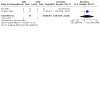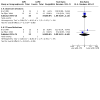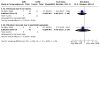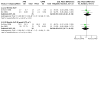Automated peritoneal dialysis versus continuous ambulatory peritoneal dialysis for people with kidney failure
- PMID: 39258519
- PMCID: PMC11388675
- DOI: 10.1002/14651858.CD006515.pub2
Automated peritoneal dialysis versus continuous ambulatory peritoneal dialysis for people with kidney failure
Abstract
Background: Peritoneal dialysis (PD) is a home-based kidney replacement therapy (KRT) performed in people with kidney failure. PD can be performed by manual filling and draining of the abdominal cavity, i.e. continuous ambulatory PD (CAPD), or using a device connected to the PD catheter that is programmed to perform PD exchanges, i.e. automated PD (APD). APD is considered to have several advantages over CAPD, such as a lower incidence of peritonitis, fewer mechanical complications, and greater psychosocial acceptability. Acknowledging the increasing uptake of APD in incident and prevalent patients undergoing PD, it is important to re-evaluate the evidence on the comparative clinical and patient-reported outcomes of APD compared to CAPD. This is an update of a Cochrane review published in 2007.
Objectives: To compare clinical and patient-reported outcomes of APD to CAPD in people with kidney failure.
Search methods: In this update, we searched the Cochrane Kidney and Transplant Register of Studies until 29 August 2024. Studies in the Register are identified through searches of CENTRAL, MEDLINE, and EMBASE, conference proceedings, the International Clinical Trials Registry Platform (ICTRP) Search Portal, and ClinicalTrials.gov.
Selection criteria: Randomised controlled trials (RCTs) comparing APD with CAPD in adults (≥ 18 years) with kidney failure.
Data collection and analysis: Two authors independently screened the search results and extracted data. Data synthesis was performed using random-effects meta-analyses, expressing effect estimates as risk ratios (RR) with 95% confidence intervals (CI) for dichotomous data and mean differences (MD) with 95% CIs for continuous data. Certainty in the evidence was assessed using the Grading of Recommendations Assessment, Development and Evaluation (GRADE) approach.
Main results: Two RCTs (131 randomised people) comparing APD with CAPD were included in this update. One RCT had a follow-up of six months, and one RCT had a follow-up of 24 months. The risk of bias in the included studies was mostly low, except for the high risk of performance bias for subjective outcomes. The evidence is very uncertain about the effect of APD compared to CAPD on death, hospitalisations, PD-related peritonitis, change of dialysis modality, residual kidney function, health-related quality of life (HRQoL), overhydration, blood pressure, exit-site infections, tunnel infections, mechanical complications, PD catheter removal, or dialysis adequacy measures. These results were largely based on low to very low certainty evidence; hence, caution is warranted when drawing conclusions.
Authors' conclusions: Insufficient evidence exists to decide between APD and CAPD in kidney failure patients with regard to clinical and patient-reported outcomes. Therefore, current evidence is insufficient as a guide for clinical practice. Given that the sample sizes of existing studies are generally small with insufficient follow-up, there is a need for large-scale, multicentre studies. Future research should focus on possible differences between APD and CAPD in residual kidney function, euvolaemia, and patient-reported outcomes such as HRQoL, symptoms, patient satisfaction and life participation.
Trial registration: ClinicalTrials.gov NCT05449067.
Copyright © 2024 The Cochrane Collaboration. Published by John Wiley & Sons, Ltd.
Conflict of interest statement
Esmee Driehuis: no relevant interests
Marga Eshuis: no relevant interests
Karlien François: speaker fees from Baxter and Fresenius; investigator‐initiated research grant funded by Fresenius; consultancy fee paid to her institution by Hemotech Belux and AstraZeneca; principal investigator of PREDICT
Alferso C Abrahams: speaker fees from Baxter and Fresenius; principal investigator of DOMESTICO and PREDICT
Robin WM Vernooij: no relevant interests
Figures














Update of
-
Continuous ambulatory peritoneal dialysis versus automated peritoneal dialysis for end-stage renal disease.Cochrane Database Syst Rev. 2007 Apr 18;2007(2):CD006515. doi: 10.1002/14651858.CD006515. Cochrane Database Syst Rev. 2007. Update in: Cochrane Database Syst Rev. 2024 Sep 11;9:CD006515. doi: 10.1002/14651858.CD006515.pub2. PMID: 17443624 Free PMC article. Updated.
References
References to studies included in this review
Bro 1999 {published data only}
-
- Bro S, Bjorner JB, Tofte-Jensen P, Klem S, Almtoft B, Danielsen H, et al. A prospective, randomized multicenter study comparing APD and CAPD treatment. Peritoneal Dialysis International 1999;19(6):526-33. [MEDLINE: ] - PubMed
De Fijter 1994 {published data only}
-
- De Fijter CW, Oe PL, Verbrugh HA, Nauta JJP, Van Der Meulen J, Verhoef J, et al. Continuous cyclic peritoneal dialysis: clinical efficacy and comparison with continuous ambulatory peritoneal dialysis [De klinische effectiviteit van een nieuwe vorm van nierfunctievervangende behandeling: continue cyclische peritoneale dialyse]. Nederlands Tijdschrift voor Geneeskunde 1995;139(13):658-64. [EMBASE: 25101590]
-
- Fijter CW, Oe LP, Nauta JJ, Meulen J, Verbrugh HA, Verhoef J, et al. Clinical efficacy and morbidity associated with continuous cyclic compared with continuous ambulatory peritoneal dialysis. Annals of Internal Medicine 1994;120(4):264-71. [MEDLINE: ] - PubMed
-
- Fijter CW, Oe LP, Meulen J, Nauta JJP, Donker AJ. Outcome in continuous ambulatory peritoneal dialysis with y-set (CAPD-Y) versus continuous cyclic peritoneal dialysis (CCPD): a prospective, randomized comparison [abstract no: 9P]. Journal of the American Society of Nephrology 1992;3(3):408. [CENTRAL: CN-00460616]
-
- Fijter CW, Oe PL, Nauta JJ, Meulen J, ter Wee PM, Snoek FJ et al. A prospective, randomized study comparing the peritonitis incidence of CAPD and Y-connector (CAPD-Y) with continuous cyclic peritoneal dialysis (CCPD). Advances in Peritoneal Dialysis 1991;7:186-9. [MEDLINE: ] - PubMed
-
- Fijter CW, Oe PL, Nauta JJ, Meulen J, ter Wee PM, Snoek FJ, et al. Peritoneal dialysis-related peritonitis: A prospective, randomized comparison between continuous ambulatory PD with Y-connector (CAPD-Y) and continuous cyclic PD (CCPD) [abstract]. Nephrology Dialysis Transplantation 1992;7(2):166-7. [CENTRAL: CN-00260685]
References to studies excluded from this review
De Fijter 1992 {published data only}
De Fijter 1994a {published data only}
-
- Fijter CW, Verbrugh HA, Oe PL, Heezius EC, Verhoef J, Donker AJ. Antibacterial peritoneal defence in automated peritoneal dialysis: advantages of tidal over continuous cyclic peritoneal dialysis? Nephrology Dialysis Transplantation 1994;9(2):156-62. [PMID: ] - PubMed
Domenici 2016a {published data only}
Eloot 2015 {published data only}
Iles‐Smith 2002 {published data only}
-
- Iles-Smith H, Curwell J, Gokal R. Comparative evaluation of CAPD and PD-plus effectiveness. EDTNA-ERCA Journal 1999;25(3):27-9. [PMID: ] - PubMed
-
- Iles-Smith H, Curwell J, Gokal R. PD plus concept leads to significant increases in solute clearances in anuric CAPD patients. Peritoneal Dialysis International 2002;22(6):719-21. [PMID: ] - PubMed
TCTR20200810001 {published data only}20200810001
-
- Pattaragarn A. The quality of life in children receiving chronic peritoneal dialysis [Feasibility study on the establishment of automated peritoneal dialysis service in National Health Security System for children with end stage kidney disease]. www.thaiclinicaltrials.org/show/TCTR20200810001 (first received 10 August 2020).
References to ongoing studies
NCT05449067 {published data only}
-
- Hou F. CAPD Versus APD in Nondiabetic Peritoneal Dialysis Patients. https://clinicaltrials.gov/show/NCT05449067 (first received 8 July 2022).
TCTR20201215007 {published data only}
-
- Sritippayawan S. Feasibility study of the inclusion of automated peritoneal dialysis and icodextrin solution for fluid overload adult chronic ESKD patients in the National Health Security System of Thailand [Automated peritoneal dialysis, icodextrin, continuous ambulatory peritoneal dialysis, Multi-centered, open-labeled randomized controlled trial]. https://www.thaiclinicaltrials.org/show/TCTR20201215007 (first received 15 December 2020).
Additional references
ANZDATA 2022a
-
- Australia and New Zealand Dialysis and Transplant Registry. ANZDATA Registry. 45th report, Chapter 1: Incidence of Kidney Failure with Replacement Therapy. Adelaide, Australia, 2022. www.anzdata.org.au/report/anzdata-45th-annual-report-2022-data-to-2021/ (accessed 27 August 2024).
ANZDATA 2022b
-
- Australia and New Zealand Dialysis and Transplant Registry. ANZDATA Registry. 45th Report, Chapter 5: Peritoneal dialysis. Adelaide, Australia. 2022. www.anzdata.org.au/report/anzdata-45th-annual-report-2022-data-to-2021/ (accessed 27 August 2024).
Astley 2023
Beduschi 2015
-
- Beduschi GC, Figueiredo AE, Olandoski M, Pecoits-Filho R, Barretti P, Moraes TP. Automated peritoneal dialysis is associated with better survival rates compared to continuous ambulatory peritoneal dialysis: a propensity score matching analysis [Erratum in: PLoS One. 2015;10(9):e0138382]. PLoS ONE [Electronic Resource] 2015;10(7):e0134047. [DOI: 10.1371/journal.pone.0134047] [PMID: ] - DOI - PMC - PubMed
Bieber 2014
Blake 2020
Brown 2020
-
- Brown EA, Blake PG, Boudville N, Davies S, Arteaga J, Dong J, et al. International Society for Peritoneal Dialysis practice recommendations: Prescribing high-quality goal-directed peritoneal dialysis. Peritoneal Dialysis International 2020;40(3):244-53. [DOI: 10.1177/0896860819895364] [PMID: ] - DOI - PubMed
Cho 2021
Churchill 1998
-
- Churchill DN, Thorpe KE, Nolph KD, Keshaviah R, Oreopoulos DG, Page D. Increased peritoneal membrane transport is associated with decreased patient and technique survival for continuous peritoneal dialysis patients. The Canada-USA (CANUSA) Peritoneal Dialysis Study Group. Journal of the American Society of Nephrology 1998;9(7):1285-92. [DOI: 10.1681/ASN.V971285] [PMID: ] - DOI - PubMed
Davenport 2009
-
- Davenport A. Peritonitis remains the major clinical complication of peritoneal dialysis: the London, UK, peritonitis audit 2002-2003. Peritoneal Dialysis International 2009;29(3):297–302. [PMID: ] - PubMed
de Wit 2001
-
- Wit GA, Merkus MP, Krediet RT, Charro FT. A comparison of quality of life of patients on automated and continuous ambulatory peritoneal dialysis. Peritoneal Dialysis International 2001;21(3):306-12. [PMID: ] - PubMed
Deeks 2022
-
- Deeks JJ, Higgins JP, Altman DG (editors). Chapter 10: Analysing data and undertaking meta-analyses. In: Higgins JP, Thomas J, Chandler J, Cumpston M, Li T, Page MJ, Welch VA (editors). Cochrane Handbook for Systematic Reviews of Interventions version 6.3 (updated February 2022). Cochrane, 2022. Available from www.training.cochrane.org/handbook.
Diaz‐Buxo 2000
Dombros 2005
El‐Reshaid 2016
GRADE 2013
-
- Schünemann H, Brożek J, Guyatt G, Oxman A, editor(s). Handbook for grading the quality of evidence and the strength of recommendations using the GRADE approach (updated October 2013). GRADE Working Group, 2013. www.gdt.guidelinedevelopment.org/app/handbook/handbook.html.
Guney 2010
-
- Guney I, Solak Y, Atalay H, Yazici R, Altintepe L, Kara F, et al. Comparison of effects of automated peritoneal dialysis and continuous ambulatory peritoneal dialysis on health-related quality of life, sleep quality, and depression. Hemodialysis International 2010;14(4):515-22. [DOI: 10.1111/j.1542-4758.2010.00465.x] [PMID: ] - DOI - PubMed
Guo 2003
Higgins 2022
-
- Higgins JP, Savović J, Page MJ, Elbers RG, Sterne JA. Chapter 8: Assessing risk of bias in a randomized trial. In: Higgins JP, Thomas J, Chandler J, Cumpston M, Li T, Page MJ, Welch VA (editors). Cochrane Handbook for Systematic Reviews of Interventions version 6.3 (updated February 2022). Cochrane, 2022. Available from www.training.cochrane.org/handbook.
Johnson 2010
Kavanagh 2004
KDIGO 2013
-
- Levin A, Stevens PE, Bilous RW, Coresh J, De Francisco AL, De Jong PE, et al. Kidney Disease: Improving Global Outcomes (KDIGO) CKD Work Group. KDIGO 2012 Clinical Practice Guideline for the Evaluation and Management of Chronic Kidney Disease. Kidney International - Supplement 2013;3(1):1-150. [DOI: 10.1038/kisup.2012.73] [EMBASE: 369856107] - DOI
Li 2022
Liyanage 2015
Luo 2023
McCormick 2003
Michels 2011
Morelle 2021
-
- Morelle J, Stachowska-Pietka J, Öberg C, Gadola L, La Milia V, Yu Z, et al. ISPD recommendations for the evaluation of peritoneal membrane dysfunction in adults: classification, measurement, interpretation and rationale for intervention. Peritoneal Dialysis International 2021;41(4):352-72. [DOI: 10.1177/0896860820982218] [PMID: ] - DOI - PubMed
Morelle 2022
Nessim 2009
-
- Nessim SJ, Bargman JM, Austin PC, Nisenbaum R, Jassal SV. Predictors of peritonitis in patients on peritoneal dialysis: results of a large, prospective Canadian database. Clinical Journal of the American Society of Nephrology 2009;4(7):1195-200. [DOI: 10.2215/CJN.00910209] [PMID: ] - DOI - PMC - PubMed
Rodriguez‐Carmona 1999
-
- Rodriguez-Carmona A, Perez Fontan M, Falcon TG, Fernandez Rivera C, Valdes F. A comparative analysis on the incidence of peritonitis and exit-site infection in CAPD and automated peritoneal dialysis. Peritoneal Dialysis International 1999;19(3):253-8. [PMID: ] - PubMed
Roumeliotis 2021
Rumpsfeld 2006
-
- Rumpsfeld M, McDonald SP, Johnson DW. Higher peritoneal transport status is associated with higher mortality and technique failure in the Australian and New Zealand peritoneal dialysis patient populations. Journal of the American Society of Nephrology 2006;17(1):271–8. [DOI: 10.1681/ASN.2005050566] [PMID: ] - DOI - PubMed
Sanchez 2008
-
- Sanchez AR, Madonia C, Rascon-Pacheco RA. Improved patient/technique survival and peritonitis rates in patients treated with automated peritoneal dialysis when compared to continuous ambulatory peritoneal dialysis in a Mexican PD center. Kidney International 2008;73(108):S76-80. [DOI: 10.1038/sj.ki.5002606] [PMID: ] - DOI - PubMed
Sunder 2008
-
- Sunder S, Kalra OP, Nashine S, Waghmare V, Ruchi R. Comparative study of adequacy of dialysis and health-related quality of life in patients on CAPD and APD. Peritoneal Dialysis International 2008;28(5):542–4. [PMID: ] - PubMed
Tang 2016
Teitelbaum 2021
Thurlow 2021
USRDS 2022
-
- United States Renal Data System. 2022 USRDS Annual Data Report: Epidemiology of kidney disease in the United States. National Institutes of Health, National Institute of Diabetes and Digestive and Kidney Diseases, Bethesda, MD, 2022. www.usrds-adr.niddk.nih.gov/2022 (accessed 27 August 2024).
References to other published versions of this review
Rabindranath 2007
-
- Rabindranath KS, Adams J, Ali TZ, MacLeod AM, Vale L, Cody J, et al. Continuous ambulatory peritoneal dialysis versus automated peritoneal dialysis for end-stage renal disease. Cochrane Database of Systematic Reviews 2007, Issue 2. Art. No: CD006515. [DOI: 10.1002/14651858.CD006515] - DOI - PMC - PubMed
Publication types
MeSH terms
Associated data
LinkOut - more resources
Full Text Sources
Medical
Research Materials

